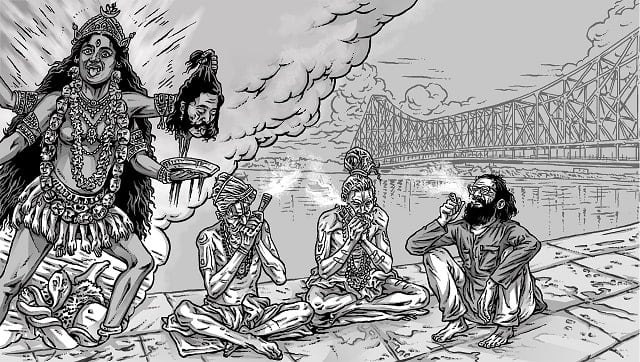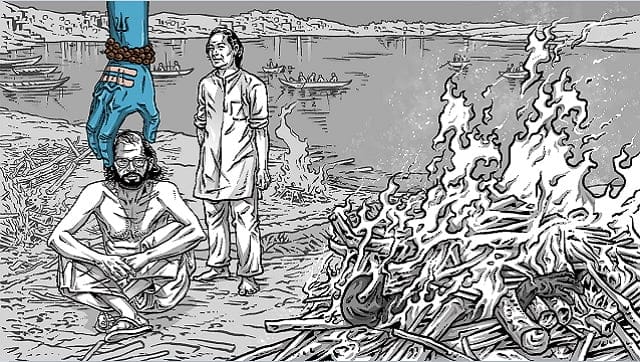In 1962 one of America’s most famous poets landed up in Calcutta. Allen Ginsberg was internationally renowned for ‘Howl’, an epic poem that had sparked an obscenity trial in San Francisco. But when he came to India, he was broke, disillusioned, fed up with the notoriety of ‘Howl’ and the media circus around its trial. “He needed to go a place that was cheap and stay there for a while. I think he wanted to escape,” says Ram Devineni, the producer and director of a new documentary called Ginsberg’s Karma about the poet’s time in India. Ginsberg also wanted to find a guru, someone whom he could love and who would love him back. In India, however, people didn’t know what to make of him. He was billed as America’s most famous living poet, yet he shacked up in a Kolkata hotel so shabby and bedbug-infested even his Bengali friends were afraid to go there, remembered the poet Sunil Ganguly. He traveled third class on trains and started dressing in kurta pajamas, looking more grungy as time went on. This was a pre-backpacker India and westerners who looked like Ginsberg were rare. “It was just not in their experience, the idea that a westerner could live so close to the streets,” says Deborah Baker, author of A Blue Hand: Allen Ginsberg and the Beats in India. To top it all, Ginsberg showed up with his lover Peter Orlovsky. “Peter would take off his clothes at the drop of a hat,” says Baker. “That obviously gave housekeepers and servants heart attacks.” In fact Ginsberg was such an odd figure many were convinced that the man who came to epitomise the hippie movement was a CIA operative. It was a most curious encounter between East and West. Fascinated with Indian mysticism, Ginsberg had an audience with the Dalai Lama (where they discussed LSD) and sought out sadhus. But the poets he met in Kolkata were hardcore rationalists, uninterested in gurus. To their astonishment, Ginsberg wanted to hang out with ganja-smoking sadhus at cremation grounds. While the poets liked their alcohol, Ginsberg was into ganja and other mind altering substances which he hoped would open up his mind. When he met the Indian writer Buddhadev Bose in New York, he was amazed that Bose had never smoked ganja. Ginsberg was looking for answers from the east but the Indians he met were looking west for a sense of cosmopolitanism. “I think the critical thing was poetry that really brought them all together,” says Devineni. [caption id=“attachment_9680231” align=“alignnone” width=“640”]  Art from Ginsberg’s Karma, by Harsho Mohan Chattoraj[/caption] Devineni’s own Ginsberg journey started almost by accident. He was part of an American delegation of poets to the Kolkata Book Fair in 2008. The book fair got cancelled because of a court order. So Devineni decided to use the opportunity to have American poet Bob Holman retrace Ginsberg’s steps. “People loved talking about Allen,” says Devineni. “We’d be there two-three hours looking through letters. Nobody had thrown anything away.” Holman tells the story with the help of archival photographs, interviews with American and Indian poets and evocative artistic recreations of Ginsberg’s time in India. Most of those poets are gone now. But Allen Ginsberg’s tryst with India still resonates in odd ways. Deborah Baker, who is married to the novelist Amitav Ghosh, says when she came to Kolkata in the 1990s, “the feelings about Americans weren’t warm, there was a lot of wariness and suspicion.” Working on her book about Allen Ginsberg in India made a difference. “That I eventually got welcomed at all was because he had been there before me. That was an American the literary crowd felt warmly about.” Ginsberg himself didn’t think much of the English writing scene in India at that time. After meeting poets like Nissim Ezekiel, Ginsberg said, “The English used in India is too polite and genteel. There is no Indian English like there is an American Negro English.” He felt more kinship with the struggling Bengali poets of Kolkata who wrote in their mother tongue. Orlovsky however complained in a letter: “Main thing we do in Calcutta is meat Bengale poets by the dozen [sic]”. When they were not meeting poets, they were meeting godmen. Ginsberg fell in the thrall of Asoke Sarkar aka Asoke Fakir. No-one knows if he was a guru, a fixer or a conman. Perhaps he was all three. He might be a liar, said Ginsberg, but he was a “beautiful liar” who showed him “low life, religious life, tantric life”. Asoke Fakir went on to have a checkered career as a go-between for the East and the West. It was through his efforts that Bob Dylan eventually met the Baul singers of Bengal who ended up on the cover of his album John Wesley Harding. “You know Allen always said that the problem with Dylan is that he’s never been to India,” says Baker. “By the time he went he was too famous.” At some level, India disappointed Ginsberg. In 1962, the war with China broke out and Ginsberg was aghast at how war-mongering everyone around him became — just like any other country. He didn’t find the guru he was looking for, or the enlightenment he craved. [caption id=“attachment_9680241” align=“alignnone” width=“640”]  Art from Ginsberg’s Karma, by Harsho Mohan Chattoraj[/caption] He wrote in his journal: Another day and I leave India, And I never crosslegged pierced Heaven With a thought or found bearded Guru In Brindaban or levitated in Bodh-Gaya… Am I a “Beatnick” Is that all the years have to offer? Or perhaps, says Devineni, he was disappointed with himself. The poet Joanne Kyger who accompanied Ginsberg and Orlovsky along with her husband Gary Snyder for part of the trip wrote a friend that: “(Allen) wants to get instantly enlightened and can’t stand sitting down.” As he returned to the US via Japan, Ginsberg finally sensed the beginnings of the change India had wrought in him. On a train ride between Tokyo and Kyoto he wrote: In this dream I am the Dreamer and the Dreamed I am That I am Ah but I have always known… In my train seat I renounce my power, so I do live I will die. Today Ginsberg’s passage to India can feel like yet another cliché of a westerner looking to the east to bequeath him the meaning of life. But Ginsberg predates that cliché. In some ways, he inspired that cliché after he went back to America and dove into the Hare Krishna chanting hippie movement. “The idea of not being a tourist, but becoming a traveller is what I think Allen really brought to America,” reflects Devineni. Cultural czarina Pupul Jayakar had looked for trendsetters who would popularise Indian exports like handicrafts, brass objects, incense in the West. “She identified Allen and he fulfilled that role by bringing India back with him and creating this hippie lifestyle,” says Baker. India might not have given him the readily packaged answer he was looking for but Baker thinks he brought India back with him. Instead of being repulsed by the nakedness of the poverty around him like many Westerners, he was drawn she says to “the fact that India doesn’t hide anything. Life is up in your face. Death is up in your face.” In an interview Ginsberg said he was amazed by “the visibility of death which is hidden and powdered and rouged and buried in a coffin in the West.” Orlovsky, who had been an ambulance driver, did not flinch from taking care of dying beggars outside their home in Benaras. Most of all, Ginsberg was moved by the kindness he was shown by those he met along the way. It opened up his heart.
Baker tells the story of Ginsberg meeting the irascible Devraha Baba in Benaras. The fierce Baba was known to have shown Indira Gandhi the soles of his feet when she came to meet him. Ginsberg found himself confessing to the Baba about his troubled relationship with Orlovsky and his own fear of dying alone. Devraha Baba sucked in his teeth, tilted his head from side to side and then, with a tenderness that pierced Ginsberg’s heart, said softly, “How wounded, how wounded.” “Allen was neurotic, he was manic, he was lovelorn,” says Baker. “India made him more comfortable in his own skin.” Part of that were the friendships he forged at the Coffee House in Kolkata. “Sunil (Ganguly) told me that he basically learned how to be a full-time poet from Allen,” says Baker. Sometimes when they missed him they would go to the burning ghats for old times’ sake. Though Ginsberg came to India to find a teacher, Baker says, “he was a great teacher himself. I really like to see Allen as a kind of saint, an American saint, doing a pilgrimage to India.”


)
)
)
)
)
)
)
)
)



